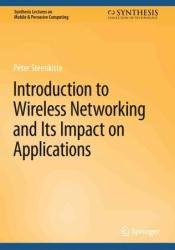 Название: Introduction to Wireless Networking and Its Impact on Applications
Название: Introduction to Wireless Networking and Its Impact on ApplicationsАвтор: Peter Steenkiste
Издательство: Springer
Серия: Synthesis Lectures on Mobile & Pervasive Computing
Год: 2023
Страниц: 131
Язык: английский
Формат: pdf (true), epub
Размер: 14.2 MB
This book teaches readers how wireless networks work, why some of their properties impact wireless network performance at the application level, and what both network engineers and application developers can do to cope with these challenges. Internet users increasingly rely on wireless access links for diverse tasks such as web browsing, video conferencing, interactive games, and data sharing. Irrespective of how they access the Internet, they expect good performance and a high quality of experience. Unfortunately, wireless access networks are much more challenging to build than wired networks. In wired networks, signals used for communication are contained in a carefully engineered transmission medium. In contrast, wireless signals travel in our physical environment, where the presence of obstacles, interference, and mobility can affect communication. In addition, network performance can differ significantly across physical environments. As a result, the performance of wireless links is often lower and less predictable than that of wired links. The author structured the book according to the layers in the Internet protocol stack, similar to traditional network books. However, rather than presenting a general description of each layer, the focus is on wireless networks and how they differ from wired networks.
The Internet has had a tremendous impact on many aspects of our lives, and one reason is the availability of high performance, low cost wireless internet access. For example, WiFi provides pervasive Internet access for a variety of applications throughout our home, office, and other environments. Cellular similarly provides virtually ubiquitous Internet access, even while we are mobile. Without wireless, Internet access would much more limited. Unfortunately, achieving good performance over wireless links is much more challenging than over wired links. The reason is that wired signals travel though a carefully engineered transmission medium, while wireless signal travel through our physical environment, which is much more challenging, especially as wireless devices, people and objects move around.
Internet communication is implemented as a set of protocols. Broadly speaking, a protocol is a set of rules that allows two parties to communicate. In the Internet, the rules cover the format of packets, interpretation of the packet contents, and a set of actions that devices must take when they receive a packet. Each device in the Internet, including endpoints and devices inside the network, implement the protocols they need as a set of modules that are organized as a 7-layer stack, based on the Open Systems Interconnect (OSI) model. Let us now briefly review the responsibilities of each layer. More details will be presented as needed in later chapters:
• Application protocols are used by distributed applications, often based on a client-server paradigm. Many application protocols have been standardized, for example HTTP (used for web browsing) and SMTP (used for e-mail). Of course, users can also implement their own custom protocols.
• Transport protocols are end-to-end protocols that ensure that packets are delivered to the right application on the destination host. They can also provide additional services such as reliable, in order delivery of data as supported by TCP.
• Network protocols are responsible for delivering packets to devices across the Internet. Today, the Internet uses the Internet Protocol (IP). Most traffic uses IP version 4, but an increasing fraction of the traffic uses version 6. Packet delivery is based on an IP address, which is 32 bits for IP v4 and 128 bits for IP v6. The IP protocol supports a minimal service: best effort packet delivery. This means that packets may be lost, reordered, or even duplicated. Most applications rely on a transport protocol such as TCP for reliable data delivery.
• Datalink protocols implement a specific network technology such as Ethernet, WiFi, or LTE. As a packet travels end-to-end, for example between the mobile device and server in our example, it often traverses multiple networks, which may use different technologies. On each network, the packet uses a different datalink header that is used transmit the packet between two routers or endpoints.
• The physical layer is responsible for transferring datalink packets between two devices connected to the same transmission medium, for example, a copper wire, optical fiber, or wirelessly. The physical layer is not a traditional protocol. It consists of rules that define how a bit stream is transmitted over an analog transmission medium.
The lecture assumes that the reader has a good background in Computer Science and in how computer systems work. Each chapter provides background, at a high level, that is relevant to the contents of the chapter. We also provide references to textbooks and papers that provide more detail.
Contents:
Скачать Introduction to Wireless Networking and Its Impact on Applications
